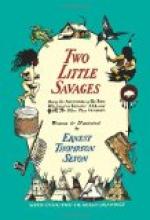Sam first went home for the Calf brains and liver, then he and Yan scraped the skin till they got out a vast quantity of grease, leaving the flesh side bluish-white and clammy, but not greasy to the touch. The liver of the Calf was boiled for an hour and then mashed up with the raw brains into a tanning “dope” or mash and spread on the flesh side of the hide, which was doubled, rolled up and put in a cool place for two days. It was then opened out, washed clean in the brook and hung till nearly dry. Then Caleb cut a hardwood stake to a sharp edge and showed Yan how to pull and work the hide over the edge till it was all soft and leathery.
The treatment of the Horsehide was the same, once the hair was removed, but the greater thickness needed a longer soaking in the “tan dope.”
After two days the Trapper scraped it clean and worked it on the sharp-edged stake. It soon began to look like leather, except in one or two spots. On examining these he said:
“H-m, Tanning didn’t strike right through every place. So he buttered it again with the mash and gave it a day more; then worked it as before over the angle of the pole till it was soft and fibrous.
“There,” said he, “that’s Injun tan leather. I have seen it done by soaking the hide for a few days in liquor made by boiling Hemlock or Balsam bark in water till it’s like brown ink, but it ain’t any better than that. Now it needs one thing more to keep it from hardening after being wet. It has to be smoked.”
So he made a smoke fire by smothering a clear fire with rotten wood; then fastening the Horsehide into a cone with a few wooden pins, he hung it in the dense smoke for a couple of hours, first one side out, then the other till it was all of a rich smoky-tan colour and had the smell so well known to those who handle Indian leather.
“There it is; that’s Injun tan, an’ I hope you see that elbow grease is the main thing in tannin’.”
“Now, will you show us how to make moccasins and war-shirts?” asked Little Beaver, with his usual enthusiasm.
“Well, the moccasins is easy, but I won’t promise about the war-shirts. That’s pretty much a case of following the pattern of your own coat, with the front in one piece, but cut down just far enough for your head to go through, instead of all the way, and fixed with tie-strings at the throat and fringes at the seams and at the bottom; it hain’t easy to do. But any one kin larn to make moccasins. There is two styles of them—that is, two main styles. Every Tribe has its own make, and an Injun can tell what language another speaks as soon as he sees his footgear. The two best known are the Ojibwa, with soft sole—sole and upper all in one, an’ a puckered instep—that’s what Ojibwa means—’puckered moccasin.’ The other style is the one most used in the Plains. You see, they have to wear a hard sole, ’cause the country is full of cactus and thorns as well as sharp stones.”




